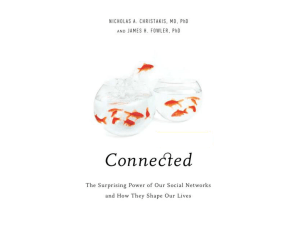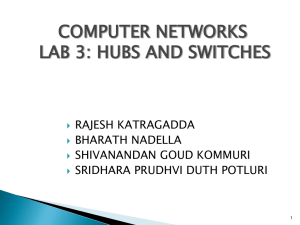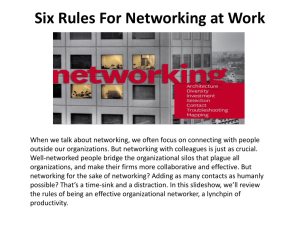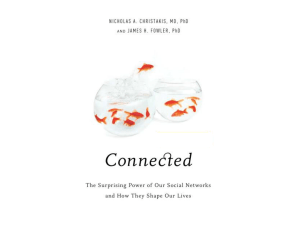Role of Weak Ties - ccb
advertisement
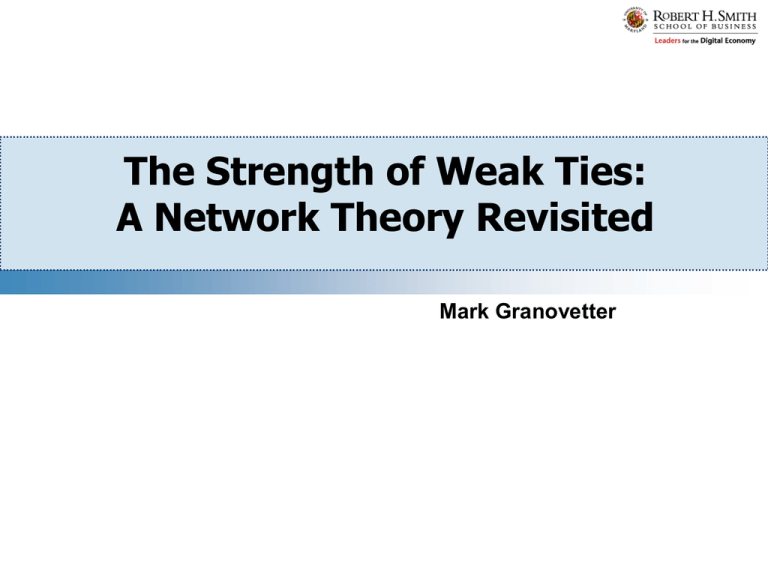
The Strength of Weak Ties: A Network Theory Revisited Mark Granovetter Weak Ties Weak Ties Ties between Ego and an acquaintance Comprise a low-density network Role of Weak Ties A crucial bridge between the two clusters of close friends - Individuals with few weak ties will be deprived of information and confined to the provincial news and views of close friends. Social systems lacking in weak ties will be fragmented & incoherent - new ideas spread slowly and subgroups separated by race, geography,…. The Impact of Weak Ties on Individuals Bridging Weak Ties Weak ties linking different groups Lead to complex role sets and the need for cognitive flexibility. Weak Ties & Opportunity for Mobility Better access to job information through weak ties For well-educated groups weak-ties are most likely to be used but less-educated groups rely on strong-ties for job search. (Ericksen and Yancey, 1980) The weak ties are effective only so far as the weak ties connect the respo ndent to a high-status individual. (Lin et al., 1981) Weak ties are more efficient at reaching high-status individuals. Only bridging weak ties are of special value. Strength of Strong Ties Strong Ties Greater motivation to be of assistance & easily accessible Relative frequency of strong ties are greater for low class. - low-status individuals are numerous as compared to high-class, easier to pick friends similar to them Strong Ties & Economic Insecurity Under strong pressure, individuals depend on strong ties. e.g., unemployment, new Ph.D.s (Murray et al., 1981) Economic Insecurity and lack of social service - Reciprocity network in black community (Stack, 1974) : share with one another because of urgency of their needs provides a minimal level of economic security Weak Ties in the Spread of Ideas Weak ties & cultural diffusion (Fine and Kleinman, 1979) Children’s culture varying by regions spread via weak ties. homogenous subcultures at the end point of diffusion process. Weak ties & scientific innovations Scientific field has a center & periphery defined by weak ties to the center and to other scientific groups Marginals can better afford to innovate and the innovations are adopted by the center. Local bridges and weak ties promote the regular flow of novel information in differentiated structures. (Friedkin, 1980) Most of the influence is carried through strong ties. (Weimann, 1980) Weak ties: marcointegration/ strong ties: microintegration Weak Ties and Social Organization Weak ties & peer socialization Weak ties can create diverse cultures without becoming similar. Weak ties can reduce student alienation and increase social solidarity. - Racial integration can be achieved by producing enough weak contacts. e.g., rearranging classroom structure (Karweit et al., 1979) Weak ties & organization integration Weak-tie mode of organizational integration (highly differentiated system of specialized staff relationship) leads to high morale and good service (Blau, 1980) The group recruited based on weak ties were able to implement many of aims while that based on strong ties was not successful. (Steinberg, 1980) Weak intercorporate ties can create cooperation and coordination while intense ties tend to produce competitive and exclusive relationship. Discussion Empirical validations How can we define weak ties & bridging weak ties in an online social net work setting? # of in and out degrees to other nodes Using self reported information about the relationship To what extent do weak ties play a role in product diffusion? Possibly depends on the product category and the extent of newness Are weak ties in one setting still weak ties in a different setting? The Role of Hubs in the Adoption Process Goldenberg, Han, Lehmann, and Hong Background Influence is a combination of personal and social factors Personality: “who one is” Competence: “what one knows” Strategic social location: “who one knows” The role of social hubs in the adoption process Hubs: individuals with a large number of social ties ≠ Opinion Leaders / innovators Even if a hub is not an innovator, a hub is more likely to adopt early due to the greater exposure. Hypotheses H1: Social hubs are more likely to adopt at the early stages Hubs will adopt first due to their greater exposure to an innovation even though they are not innovators. H2a: When hubs adopt, the overall adoption process speeds up. H2b: Innovator hub adoption has a larger correlation with speed of adoption than follower hub adoption. More connections will be activated once hubs adopt adoption rate ↑ Since innovator hubs adopt earlier than follower hubs, they have more time to influence the network. Hypotheses H3: The higher the relative out-degree of a hub, the greater impact it has on adoption. in-degree: the number of people who convey information to hubs related to when a hub adopts. out-degree: the number of people to whom hubs convey information the influence of hubs on subsequent adoption Hypotheses H4a: Hubs adoption increases the eventual size of a market. H4b: Follower hubs have a stronger relation to market size than innovative hubs. Adoption by hubs exposure of an innovation to the market ↑ market size ↑ Homophily effect : follower hubs are more similar to most of the population in terms of innovativeness more influence on the main market. H5: Hub adoption at an early stage can be used to predict product success. If hubs do not adopt a product soon after its introduction, this may impede adoption by those are connected to the hubs. Data & Measures Data Data from a Korean social network site, Cyworld “Scrapping”: adopting items such as pictures or video clips from other people’s blogs people visit. Collected item #, time of scrap, creator ID, # of in & out degrees of nodes Measures Out-degree: # of other nodes ever visited by the hub In-degree: # of other nodes that have visited the hub Hubs: people with in and out degrees larger than three standard deviations above the mean Innovativeness: the average # of people who adopted an item in the neighborhood is in the 16% of all hubs. Empirical Results Adoption timing Hub adoption decline over time while nonhub adoption increases over time. Social hubs are more likely to adopt at the early stages. (H1 supported) Hubs adopt early even if they are not innovative. (See Table 2) Speed of adoption process Hub adoption had stronger impacts on the adoption speed than typical adoption. (H2a supported.) An Innovative hub’ effect on the adoption time more than twice that of a follower hub. (H2b supported) Mean time adoption of a node linked to innovative hubs: when 55% adopted vs. that of follower hubs: when 69% adopted Hubs that have higher out degrees than in degrees seem to be more effective. in speeding the adoption process. (H3 supported.) Empirical Results Market size The number of hub adoptions is a good predictor of eventual market size. (H4a supported) Follower hubs have around seven times impact on the market size than innovative hubs (H4b supported.) Predicting Product Success Test whether hub adoption can predict product success (top 30 popular items vs. 30 moderately successful items) Even when using hubs that adopted at 5% adoption level, 80% hit. Using only small sample of hubs (280 hubs) adopted at 5% adoption rate, 70% hit. Contributions & Limitations Contributions Empirical validation of the role of social hubs in the product diffusion process using a network data in a natural setting Linking individual level network characteristics to aggregate diffusion. Can be used for predict product success Limitations Generalizability to other settings - Costs of “Scrapping” is almost close to 0. Is diffusion only a function of exposures to an innovation? Is “scrapping earlier than others” related to innovativeness? - “Scrapping” can be viewed as somewhat lazy, passive activity. Discussion Incorporating other characteristics of hubs Whether a hub is bridging diverse nodes or not can affect the adoption process. Predicting product success using social hubs For some products (e.g., luxury, fashion items), adoption by the mass is not the goal while for some products (e.g., pop music, movies) it is critical to appeal to the mass market. How do the roles of social hubs differ in these different settings? Can we still predict the product success for luxury goods using the adoption of social hubs? The end Thank You! 17 / 10
